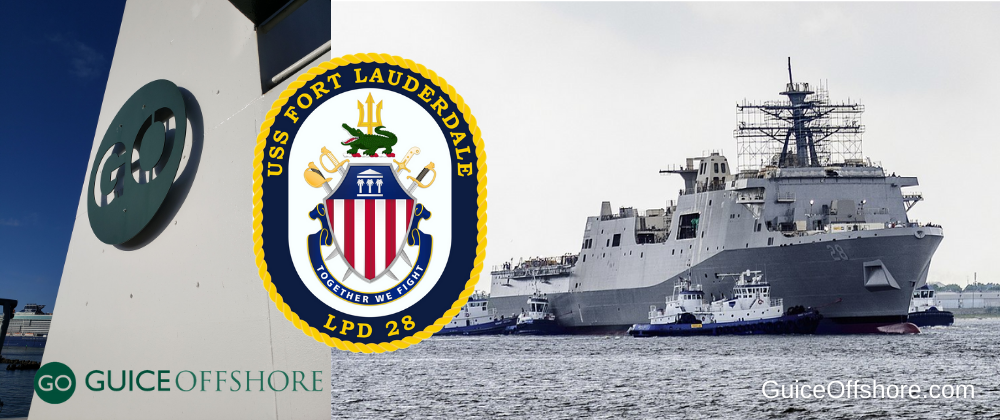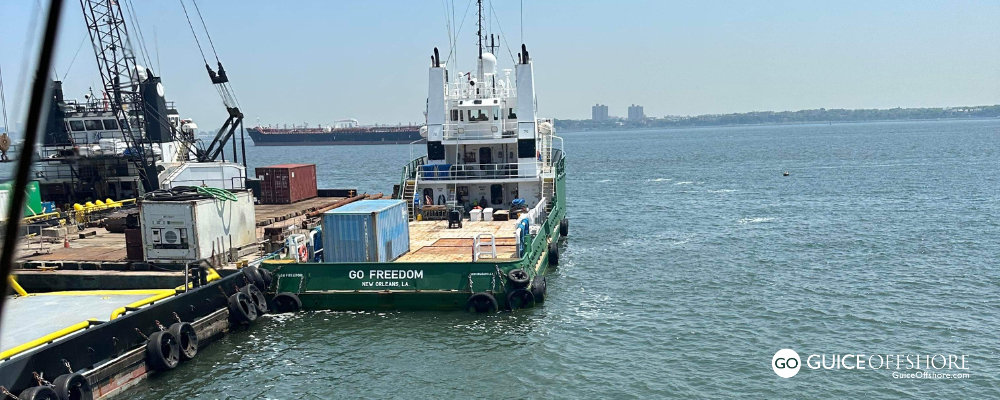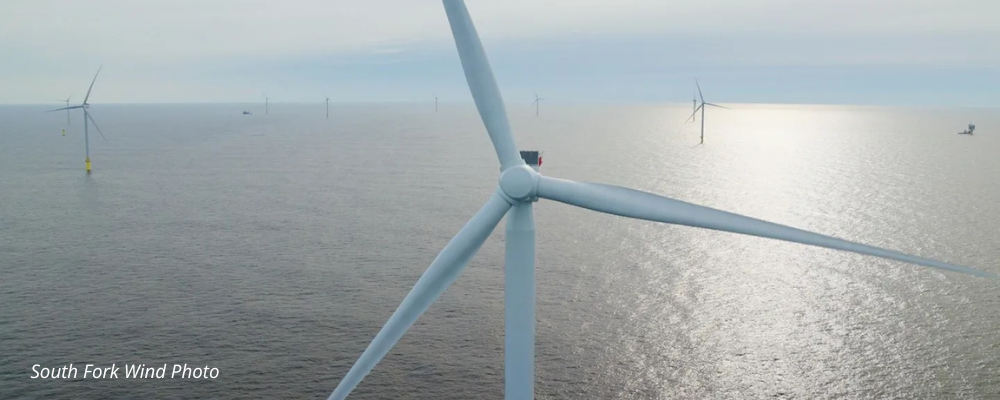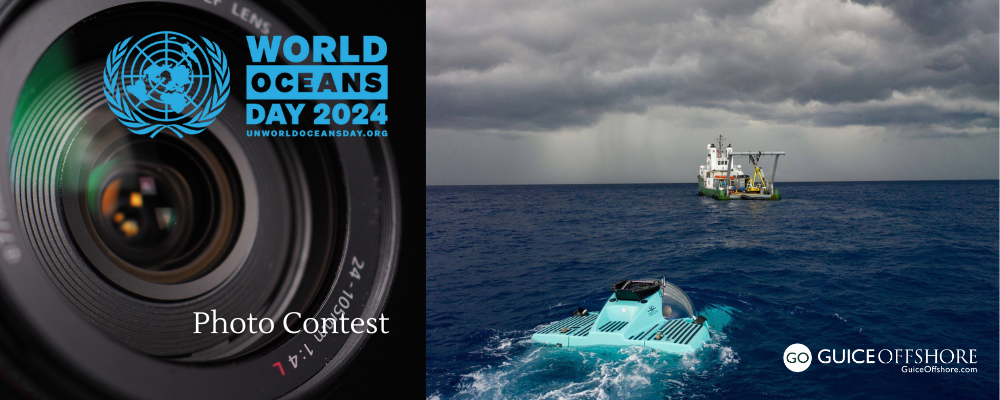Sometime during the Summer of 2022, the Guice Offshore vessel GO America, which makes her home at Fort Lauderdale’s Port Everglades, will have a front row berth from which to bear witness to a unique convergence of history when the U.S. Navy commissions its newest ship, the future U.S.S. Fort Lauderdale IN Fort Lauderdale!
The future U.S.S. Fort Lauderdale (LPD 28) was successfully launched at the Huntington Ingalls shipyard in Pascagoula, Mississippi on March 28, 2020. The ship, which will be designated as “U.S.S.” once it is commissioned, is the Navy’s 12th San Antonio class amphibious transport dock ship. To read more about the San Antonio class ships, click here.
Ingalls was awarded the contract to build LPD 28 in December 2016, her keel was laid down in October 2017 and she was launched in March 2020.
“Once delivered, this ship will join our Navy/Marine Corps team and expand the advantage we have against our adversaries,” said Vice Adm. William Galinis, commanding officer of Naval Sea Systems Command. “There are few nations that can build ships like this. Our United States shipbuilding industrial base is the envy of every major Navy in the world. The talents and skills of our shipbuilders, combined with the tenacity and toughness of our sailors and Marines, make this team second to none.”
San Antonio class ships support embarking, transporting, and landing elements of 650 Marines by landing craft or air cushion vehicles. The Fort Lauderdale’s capabilities are further enhanced by its flight deck and hangar, which can operate CH 46 Sea Knight helicopters and the Osprey tilt-rotor aircraft (MV-22). Because of the ships’ inherent capabilities, they are able to support a variety of amphibious assault, special operations or expeditionary warfare missions, operating independently or as part of Amphibious Readiness Groups (ARGs), Expeditionary Strike Groups, or Joint Task Forces.
“I am thrilled to get Fort Lauderdale in the water, so we can begin final outfitting and eventually take the ship out to sea for trials,” Capt. Scot Searles, LPD 17 class program manager for Program Executive Office (PEO), Ships said last year at the launch. “The San Antonio class has proven essential to expeditionary warfighters, and we are eager to deliver another ship to the fleet.”
The U.S. Navy and the City of Fort Lauderdale share a long, storied history dating back to the 1830s. The City also served as a key Navy training center during World War II. In Navy tradition, the ship’s insignia is rich with symbolism honoring that relationship.
According to the United States’ Institute of Heraldry, the future U.S.S. Fort Lauderdale’s Shield is described as “A Paly of nine Gules and Argent, a chief Azure bearing a Fort Lauderdale historical marker Proper.” Its Crest as “From a wreath of the colors Argent and Gules, a demi-trident Or, surmounted by an alligator Proper.”
More specifically and colloquially, the ship’s Shield pays homage to its namesake with red, white, and blue, which are both our National colors, as well as the colors used on the City of Fort Lauderdale’s flag and seal. The division of the shield alludes to the shield used on the Great Seal of the United States and is emblematic of the City of Fort Lauderdale’s role in American history. The ship’s main symbol consisting of a fort with palm tree columns is taken from the Fort Lauderdale historical markers used throughout the City to denote points of interest. Importantly, it acknowledges the City’s longstanding connection to the U.S. Navy through the three palms within the symbol, which refer to the three forts named “Fort Lauderdale” that existed long ago before construction of the modern city as we know it. The first fort was at the fork of the New River, the second was just west of Tarpon Bend on the New River, and the third was close to the famed Bahia Mar Marina.
The ship’s Crest adopts the first-named metal and color from the shield and blazon. The trident is used to symbolize the ship’s ability to strike from the sea. An alligator stands protectively in front of it, representing the “Gator Navy” which refers to a class of Navy ships, including LPDs like the future U.S.S. Fort Lauderdale, that are designed to support Marine Corps operations. These ships carry Marines along with their aircraft, equipment, and supplies to conduct assaults on hostile shores. Used as a symbol of ferocity and strength on both land and sea, the alligator further denotes the amphibious function of the vessel. Alligators are also native to Fort Lauderdale and are expressive of the exotic wildlife and landscape the area is known for.
Behind the shield are four swords–a U.S. Navy Officer’s sword, U.S. Marine Corps Officer’s Mameluke, U.S. Navy Chief Petty Officer’s cutlass and a U.S. Marine Corps Non-commissioned Officer’s sword, all in saltire (St. Andrews Cross), points downward.
The ship’s motto is “A scroll Azure, edged Or, with the inscription “TOGETHER WE FIGHT” Argent.”
Guice Offshore Vessels Support America’s Military and Government Missions
Guice Offshore is very honored to support our men and women in uniform and the many other branches of the U.S. Government. Our fleet of offshore supply vessels are regularly employed in a variety of government and military support roles including research and development, offshore training and drills, logistics and special projects.
Our Multi-Purpose Vessel GO America, based in Port Everglades, Florida, operates in conjunction with our partners Global SubDive (GSD) to support a large array of government projects, often utilizing GSD submarines and ROVs.
Similarly, our partner Ryan Marine is an expert in the field of unmanned vehicle operation which allows us to provide turnkey AUV and UUV services to government agencies anywhere in the United States and Caribbean.



